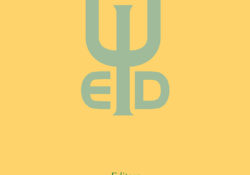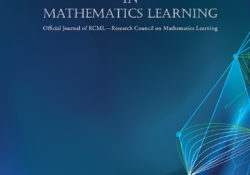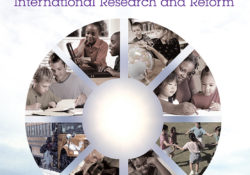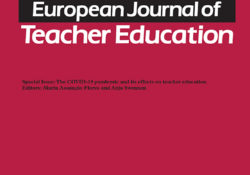tandfonline.com har udgivet en rapport under søgningen “Teacher Education Mathematics”: ABSTRACT ABSTRACT Sociocultural diversity in classrooms can result in inequality, when discontinuities between school and home make children perform below their abilities. Funds of knowledge/identity theory makes a plea for building on the skills and knowledge that students acquire in their families, communities and peer groups, and that may not be recognised by teachers, when they are from different sociocultural backgrounds to their students. In a collaborative action research project the authors investigated how primary school teachers can use students’ funds of knowledge/identity (FoK/I) in their superdiverse classrooms. Data were collected through pre-structured logbooks, teacher interviews and focus groups. The analyses result in a framework that suggests ways to find students’ FoK, and that categorises FoK/I-related teaching practices along two… Continue Reading →
Like this:
Like Loading...
tandfonline.com har udgivet en rapport under søgningen “Teacher Education Mathematics”: Abstract Abstract Openness is a foundational principle in science. Making the tools and products of scientific research openly accessible advances core aims and values of education researchers, such as the credibility, equity, impact, and efficiency of research. The digital revolution has expanded opportunities for providing greater access to research. In this article, we examine three open-science practices—open data and code, open materials, and open access—that education researchers can use to increase accessibility to the tools and products of research in the field. For each open-science practice, we discuss what the practice is and how it works, its primary benefits, some important limitations and challenges, and two thorny issues. Link til kilde
Like this:
Like Loading...
tandfonline.com har udgivet en rapport under søgningen “Teacher Education Mathematics”: ABSTRACT ABSTRACT It is commonly assumed that the reason many young people do not participate in informal STEM education (ISE) is because they lack interest in STEM. This paper draws on survey (n = 1,624) and qualitative data (n = 36) with young people aged 11–14 to examine the ways in which science dispositions, demographic characteristics, ‘consumption’ of cultural practices and exclusion interact to produce unequal forms of STEM participation. Latent class analysis generated six groups within our quantitative dataset: three groups who infrequently participated in designed and community ISE practices (Underserved Tech Enthusiasts, Underserved Creatives and Underserved Scientists), one group who only participated in specific forms of ISE practices (Partly Served Generalists) and two groups who frequently participated across a broad range of… Continue Reading →
Like this:
Like Loading...
tandfonline.com har udgivet en rapport under søgningen “Teacher Education Mathematics”: Link til kilde
Like this:
Like Loading...
eric.ed.gov har udgivet: This survey of 316 Precalculus, Calculus AB, and Calculus BC students from markedly different socioeconomic levels in four district high schools in San Antonio, Texas, looked at factors that have traditionally caused women to avoid mathematics, and attempted to discover which of them continue to influence women’s decisions to reject the discipline. The questionnaire contained 25 questions based on assumptions drawn from literature on the subject. Reported and discussed are all differences in gender opinion above 9 percentage points, even though a difference of 11.4 percentage points would begin to indicate a statistically significant result. Findings where such differences occur showed that: (1) mathematics enrollment favored men, especially in BC Calculus; (2) female respondents more frequently perceived no bias in teacher expectations; (3) female students less frequently… Continue Reading →
Like this:
Like Loading...
eric.ed.gov har udgivet: This digest addresses the issue of sex differences in mathematics achievement in K-12 students. The problem is discussed in three sections. The first section examines the progress that has been made in narrowing the gap between girls’ and boys’ achievement in mathematics and the numbers of women and men who enter mathematics-related careers. Issues addressed include the failure of research to find any inherent differences in girls’ and boys’ abilities in mathematics, the underrepresentation of women in mathematics-related fields, strategies to motivate girls to take more mathematics courses, and strategies to encourage girls to consider mathematical and scientific careers. The second section offers innovative approaches in mathematics education funded by the Women’s Educational Equity Act (WEEA) Project. A list of the products mentioned in the article is… Continue Reading →
Like this:
Like Loading...
eric.ed.gov har udgivet: Influences on sex equity in mathematics achievement are discussed in this summary of research and recommendations. Information on the following topics is presented, with each finding referenced to a source or sources in the bibliography provided at the end of the report: mathematics enrollment, influences on mathematics participation, predicting mathematics achievement, sex differences in attitudes toward mathematics and in mathematics achievement, visual/spatial skills, parents, peers and significant others, teachers, classroom environment, school structure, testing, advanced placement girls, career aspirations and educational goals, and recommendations to parents, teachers, and school personnel. Forty-four references are included in the bibliography. (MNS) Link til kilde
Like this:
Like Loading...
eric.ed.gov har udgivet: Many of the National Science Foundation-funded math curricula offer (or will be offering) staff development workshops to accompany the adoption of the curricula in schools and districts. While much of this staff development focuses on providing teachers with a solid grounding in the mathematical content of the curricula, an opportunity exists within these efforts to incorporate equity in a substantive way. As part of the Weaving Gender Equity into Math Reform project, we hope to provide teachers, administrators, staff developers, and others with the tools to implement themes and practices related to equity in their professions. Our project is focusing on how issues of gender, ethnicity, socioeconomic status, and language play out in the elementary reform math classroom. We plan to capitalize on staff development geared toward… Continue Reading →
Like this:
Like Loading...
tandfonline.com har udgivet en rapport under søgningen “Teacher Education Mathematics”: ABSTRACT ABSTRACT Globalization brings benefits such as economic growth and exposure to new products and people. Yet it also brings risks, as shown most recently by the COVID-19 pandemic. Here, we introduce a special section on how American k-12 schooling is responding to that pandemic. While media coverage has arguably overstated the dangers of COVID-19, this introduction and the three papers in this special section offer more empirical takes, which together suggest more pragmatism than partisanship in public responses. In the introduction, we compare U.S. and international schooling responses to the pandemic, in part using a survey of informants in 21 nation-states. Generally, the U.S. is taking a more cautious approach than most other developed countries regarding school reopening. Second,… Continue Reading →
Like this:
Like Loading...
tandfonline.com har udgivet en rapport under søgningen “Teacher Education Mathematics”: ABSTRACT ABSTRACT This mixed-methods study was designed to measure and elaborate constructs of faculty online readiness from pre- COVID-19 pandemic literature. Bringing together the validation of a scale to measure these constructs and insights from a focus group, findings suggest that the negative connotations of risk-taking and making mistakes while learning to teach online seem to have been mitigated by a combination of affective factors such as humility, empathy, and even optimism. Teacher educators explained that transitioning online in a context of a crisis contorts normal longitudinal perceptions of preparation and readiness. This new sense of temporality was connected to unexpected benefits of bringing them into partnership with their students. However, quantitative and qualitative results are interpreted to show that… Continue Reading →
Like this:
Like Loading...





